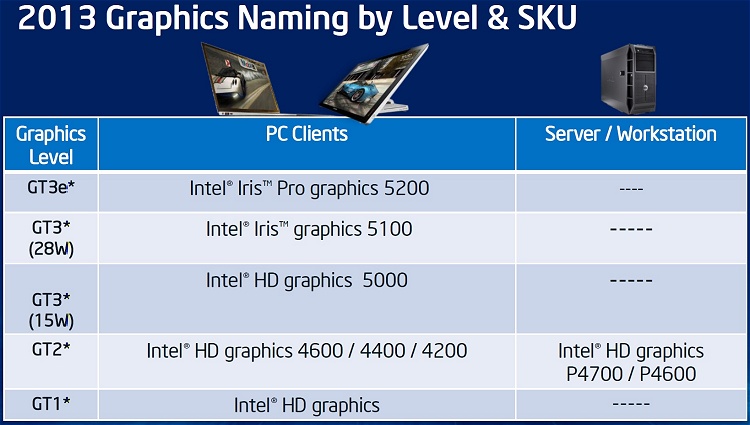Intel Haswell Makes Its Debut: Core i7-4770K Review > 4th Gen Intel HD Graphics
fourth Gen Intel HD Graphics
Intel debuted on-die HD graphics with the Westmere compages, although to be precise it wasn't actually on-die but on-parcel, significant the graphics engine was divide from the CPU. Furthermore, it was built using the 45nm procedure and not the same 32nm process used by the actual CPU.
And so the second generation graphics (Sandy Span) changed all that by including the GPU on-dice. Even though both processing units were nether the same roof, the GPU was all the same independent of the CPU. It featured its own clock domain that could be set independently and could be powered down equally needed.

This same design principle was used for Ivy Span, Intel simply added more horsepower. At that place were two versions of the Intel Hd graphics with the Ivy Bridge processors using either the HD 2500 or the faster HD 4000 engine.

The shaders, cores and execution units are what Intel calls EUs (Execution Units) with HD 2500 featuring vi and the speedier HD 4000 getting 16. Interestingly, well-nigh Core i5 desktop processors used the slower Hd Graphics 2500 engine, while all mobile processors received the 4000 engine.
Haswell offers many more than flavors of congenital-in graphics.
Starting at the bottom of the food chain we have the Intel Hd Graphics 4600/4400 and 4200. The adjacent level upwardly is the Intel Hard disk drive Graphics 5000 and so Intel Iris Graphics 5100 and Iris Pro 5200.
Now considering nosotros only have the Core i7-4770K today we can evidence yous how the Intel HD Graphics 4600 performs. This is the choice of congenital-in graphics that a broad majority of Core i7 (all except one) and all Cadre i5 desktop processors will receive. The Hard disk 4600 gets 20 EUs, a 25% increase over Ivy Bridge. The clock speed has besides been increased from 1150MHz to 1250MHz, a mild 9% bump in frequency.
The Intel Hd Graphics 5000 and Iris Graphics 5100 receive 40 EUs awarding them twice the ability-performance of HD 4xxx. So the Iris Pro Graphics 5200 which still features the same xl EUs gets a large embedded DRAM cache to improve bandwidth performance.
Source: https://www.techspot.com/review/679-intel-haswell-core-i7-4770k/page2.html
Posted by: iveyalose1946.blogspot.com


0 Response to "Intel Haswell Makes Its Debut: Core i7-4770K Review > 4th Gen Intel HD Graphics"
Post a Comment